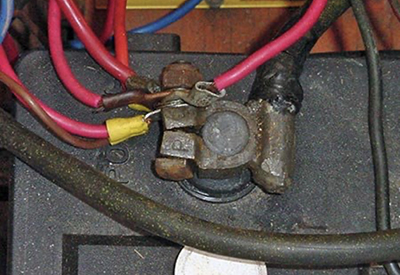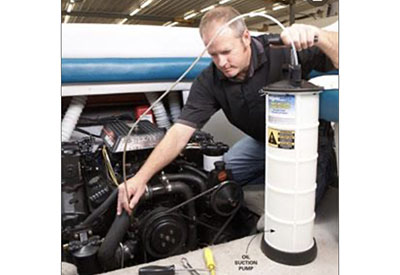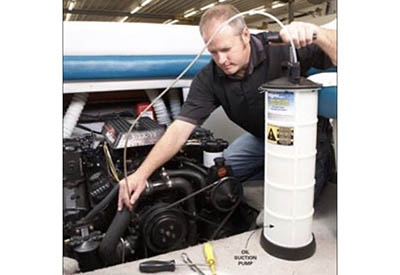Ask Andrew: Electrical Installations – Part 2: fuses and breakers

Jan 24, 2019
Last time we looked at making proper electrical connections – the tools, supplies and methods needed to make connections between components and wiring.
When planning out electrical work, one of the more common questions that I address is on the set-up, installation and sizing of breakers and fuses.
Fuses and breakers are collectively called ‘overcurrent protection’ – and these come in many different shapes, styles and sizes. Their purpose is the same: to prevent a situation where a larger than intended electrical current is running through the circuit, which puts the circuit at risk of overheating, fire and damage to equipment. A fuse is a thin metal strip that melts or breaks when too much current flows through it. A breaker is an automatic switch that opens when too much current flows through it. A fuse is designed to be replaced each time to breaks (it can’t be re-used), where a circuit breaker can be re-set and re-used repeatedly.
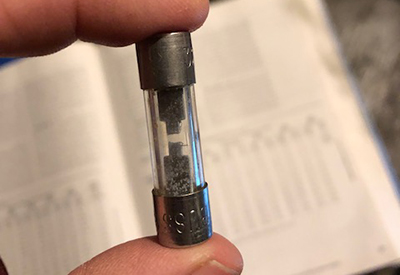 An example of a fuse that has blown – note the break in the metal inside the tube
An example of a fuse that has blown – note the break in the metal inside the tube
A situation where excess current runs through a circuit can be caused by: a faulty battery, a ground fault, a short circuit, or a broken/faulty appliance. In each of these circumstances, the fuse breaks (or the breaker trips), which stops current from running through the circuit (the circuit is now incomplete), preventing any additional damage, overheat, or fire. As you can see, fuses and breakers are essential components of each electrical circuit. To reinforce this point, the most recent data suggests that electrical shorts are the number one cause of fires on boats, and that 55% of boat fires are electrical in origin (mostly in the DC circuits.)
I regularly see a number of problems with overcurrent protection aboard both power and sail boats:
1) No fuses or breakers at all.
2) Not every appliance with a separate fuse or breaker
3) Improperly sized fuses or breakers
4) When fuses or breakers trip regularly, the fault isn’t investigated further.
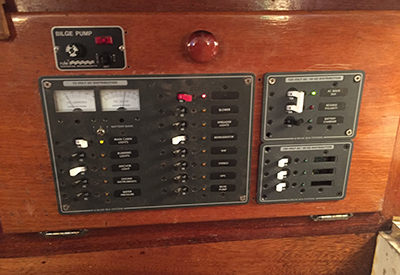 An example of a distribution or ‘breaker’ panel, with breakers of varying amperage installed. Note on the AC panel, the breakers have yet to be installed. The tech is waiting to determine the amperage of the appliances and the ampacity of the wiring
An example of a distribution or ‘breaker’ panel, with breakers of varying amperage installed. Note on the AC panel, the breakers have yet to be installed. The tech is waiting to determine the amperage of the appliances and the ampacity of the wiring
The American Boat and Yacht Council (ABYC – www.abycinc.org) sets out a list of standards that marine mechanics, technicians, and manufacturers should follow with electrical installations and repair. These standards (broken down and paraphrased) recommend the following:
1) Every electrical circuit on a boat must be protected in some way – usually using a fuse or breaker
2) The one exception are the circuits used solely for data transfer between electrical devices
3) A fuse or breaker should not be chosen based on the current rating of the appliance (example: a light that draws 2 amps), but rather based on the size of the smallest wire in the circuit (as the main concern is the protect the wiring in the circuit from melting down). This is determined by checking the ampacity of the smallest cable, using an ampacity chart
4) Ensure that the fuse or breaker is no higher than the cable ampacity, and at least as high as the continuous load of the appliance (as long as the load doesn’t exceed the ampacity of the cable.)
 An example of an ampacity table, published by the ABYC
An example of an ampacity table, published by the ABYC
A final note on repairs to electrical systems: if a fuse blows regularly, or if a breaker trips continuously, there is a problem to be identified (a short circuit, faulty appliance, or ground fault) that should be investigated and repaired.
NOTE: Installing a larger size fuse is not an appropriate solution. The fuse/breaker is meant to be the first part of the circuit to fail. If a larger size is installed, this may mean that the wiring becomes the first part of the circuit to fail – which can cause melted wiring or a fire. The most appropriate action to take is to determine the cause of the circuit overload, repair it, replace or upgrade any wiring or connections (as necessary) and maintain the fuse size to protect the circuit correctly. If in doubt, check ampacity tables, ABYC electrical standards, and/or a qualified marine technician.
Stay safe on the water!
 Andrew McDonald is the owner of Lakeside Marine Services – a boat repair/maintenance firm based in Toronto. Andrew has worked in the marine industry for 12 years and is a graduate of the Georgian College ‘Mechanical Techniques – Marine Engine Mechanic’ program.
Andrew McDonald is the owner of Lakeside Marine Services – a boat repair/maintenance firm based in Toronto. Andrew has worked in the marine industry for 12 years and is a graduate of the Georgian College ‘Mechanical Techniques – Marine Engine Mechanic’ program.
Questions or comments for Andrew? Email him directly via: askandrew@lakesidemarineservices.ca

